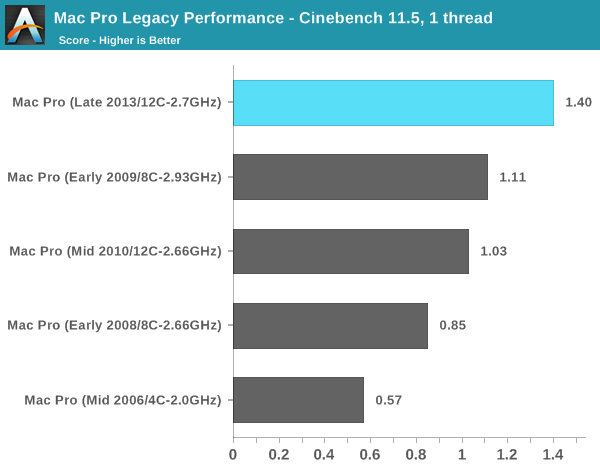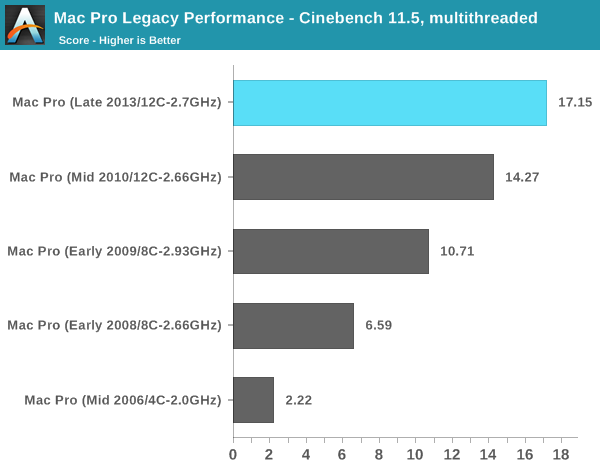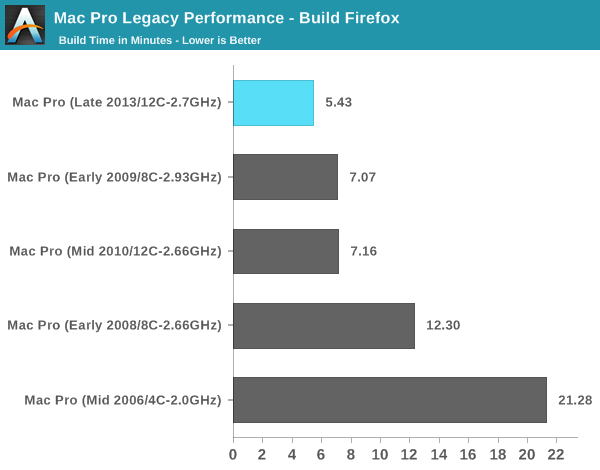The Mac Pro Review (Late 2013)
by Anand Lal Shimpi on December 31, 2013 3:18 PM ESTCPU Performance
I like to have large historical databases of performance so I can put new products in perspective. The Mac Pro and its funny lineage make this a little difficult. For starters, I simply haven't reviewed all of the Mac Pro CPU combinations that have existed over the years. Then there's also the fact that not all of my Mac suite applies well to a 12-core/24-thread Mac Pro. I'm going to try my best to put the new Mac Pro's performance in perspective, but it's going to require a couple of subsections.
Let's first start with a look at the historical performance of the Mac Pro. I really have to thank @elfurberino and @tapbot_paul for lending their time (and their Mac Pros) to help flesh out this comparison. With their help I managed to put together performance data for almost every single generation of Mac Pro.
We'll start with Cinebench R10's single threaded test. Unfortunately the benchmark crashes on Macs with 16+ threads so single threaded performance is all we'll be able to look at:

That's right, I still have my old PowerMac G5 Dual 2.5GHz (upgrade from my original 2.0 model). It's interesting to note that single threaded performance has only improved by 2.8x over that 2.5GHz dual G5 machine from around a decade ago. If we were able to also look at multithreaded performance we'd see a much larger gap. The dual G5's multithreaded performance is actually lower than the single threaded performance of the new Mac Pro's IVB-EP (3346 vs 5187). And the new Mac Pro has 12 of those cores.
Here you can see a very healthy increase in single threaded performance over the 2010/2012 12-core system. The 34% increase in performance is because the Mac Pro never got the Sandy Bridge bump. All previous Mac Pros topped out at Nehalem/Westmere. Couple all of the Sandy Bridge improvements with the much higher peak clock speeds (3.5GHz vs. 3.0GHz) and the performance gains make sense.
The 8C system from early 2009 gives us an example of how it's very possible to have a newer Mac Pro actually perform worse than its predecessor. Apple has done a relatively good job this round of keeping the core count/frequency tradeoffs sensible, but you still have to align your silicon choices to your workload.
Moving on to Cinebench 11.5, we lose the PowerMac G5 comparison but we gain a more modern benchmark. Once again we'll start with the single threaded numbers:

There's that healthy single threaded performance bump again. It is pretty incredible to me just how far we've come in single threaded performance since the mid-2000s. What's even crazier is that 2.0GHz Mac Pro from 2006 is only about 40% faster than a Bay Trail tablet with an Atom Z3770.

The multithreaded story is more evolutionary for sure, especially compared to the previous generation 12-core model. Here we're showing a 20% gain over the previous 12-core design. If you're migrating from a machine with fewer cores you can expect a corresponding increase in multithreaded performance. What is most surprising here is that a 2.3GHz 15-inch MacBook Pro with Retina Display (Late 2013) actually offers better multithreaded performance than the 8-core 2.66GHz Mac Pro from early 2008 in the chart above. The new 15-inch rMBP scores a 6.62 here compared to the 6.58 of that old Mac Pro.
I also shared my Firefox build test with Adam and Paul, who helped me fill out the chart below:

There isn't much of an advantage to having 12 cores here, but the new Mac Pro does deliver an amazingly quick build time compared to anything else. The new Mac Pro is good for around a 24% improvement in build performance compared to the outgoing 12-core model.










267 Comments
View All Comments
Ryan Smith - Wednesday, January 1, 2014 - link
The device ID for the D700 is identical to the 7970 (1002-6798), so it will show up as a Radeon under Windows. Conversely, a 7970 may very well show up as a D700 under Mac OS X if the only thing being checked is the device ID.666sheep - Thursday, January 2, 2014 - link
It used to be device ID only, but it has changed in 10.9.2 drivers. Now 7970 (and 7870 XT) are recognized as "themself", like in 10.8. So there's another check, most likely vendor and/or subsystem ID.BTW, D500 and D700 are based on the same core - Tahiti XT2 and share one EFI ROM (but not the PC part, these are different for each card). I sent Anand an email with more detailed info.
tipoo - Thursday, January 2, 2014 - link
But can you install FirePro drivers for it under Windows?666sheep - Friday, January 3, 2014 - link
I doubt that at this moment drivers other than Apple Bootcamp ones will detect these cards as FirePro. One should test this empirically, though.wheelhot - Saturday, January 4, 2014 - link
Yes, I'm one of them as I'm using Solid Edge in Windows and wonders if the D300/500/700 is supplied with actual FirePro drivers in Windows or not. Anyone care to clarify?I've been searching for anyone to run a specviewperf test as it'll be easier to know if they truly comes with a FirePro GPU drivers or not in Windows, sadly none yet :(
melgross - Tuesday, December 31, 2013 - link
I'd like to see a comparison pricing between the Mac Pro and a DIY machine using the same processors, not the i7. Whatever the difference, it's not the same type of machine if the CPU's are entirely different. That price difference, and possibly that of the mobo will be drastic, I would imagine, and would be a fairer comparison.acrown - Tuesday, December 31, 2013 - link
Lucky for you that someone did that already then:http://www.futurelooks.com/new-apple-mac-pro-can-b...
Spoiler - the Mac Pro is cheaper when you attempt to keep the same design restraints.
lilo777 - Tuesday, December 31, 2013 - link
Don't be ridiculous. The guy has no clue. He used two AMD W9000 cards as if this is is what D700 is.itpromike - Tuesday, December 31, 2013 - link
Apparently you have no clue... The W9000 is spec for spec the exact same card as the D700. Every single spec and number are identical. Aside from Apples stupid and pointless naming convention this card is the same.KVFinn - Tuesday, December 31, 2013 - link
>The W9000 is spec for spec the exact same card as the D700. Every single spec and number are identical.The W9000 is different, it has ECC ram for example. It's spec for spec the same as the 7970 but clocked lower.
Though most of the differences in Pro grade GPU are confined to drivers.